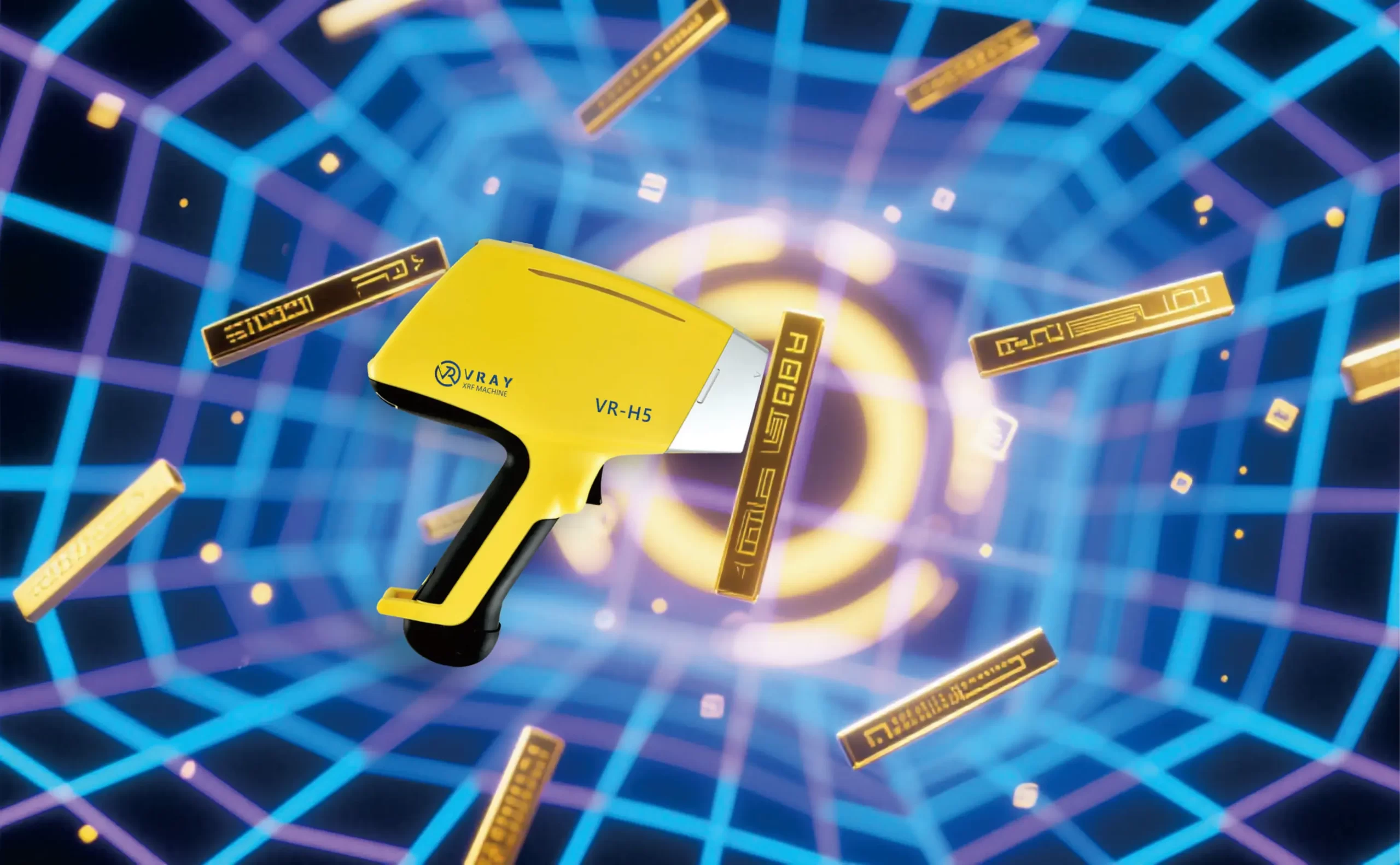Bagaimana cara kerja penganalisa logam yang dipegang tangan?
A genggam penganalisis logam bekerja dengan menggunakan fluoresensi sinar-X (XRF) teknologi untuk mengidentifikasi dan mengukur unsur-unsur dalam sampel logam. Saat perangkat diarahkan ke sampel, ia memancarkan sinar-X yang berinteraksi dengan atom-atom dalam material. Interaksi ini menyebabkan atom melepaskan sinar-X sekunder, yang dideteksi dan diinterpretasikan oleh penganalisa. Dalam hitungan detik, pengguna menerima informasi rinci tentang komposisi logam — termasuk keberadaan logam mulia sejenisnya emas, perak, dan platinum — tanpa menyebabkan kerusakan apa pun pada sampel.

Teknologi canggih ini kini cukup ringkas untuk dimasukkan ke dalam perangkat portabel, memungkinkan perhiasan, Penyuling, pendaur ulang, dan inspektur untuk menguji logam di tempat dengan cepat dan percaya diri. Untuk bisnis yang mengandalkan analisis logam yang akurat, terutama dalam skenario bernilai tinggi seperti pengujian kemurnian emas atau pengendalian kualitas, sebuah perangkat genggam analisis logam bukan sekedar alat — ini adalah keunggulan kompetitif.
Apa yang Membuat Alat Analisa Logam Genggam Begitu Efektif?
Alat analisa logam genggam telah mengubah cara para profesional mengevaluasi bahan logam. Inilah alasan mengapa mereka diadopsi secara luas:
- Pengujian Non-Destruktif: Tidak ada pemotongan, goresan, atau merusak sampel — cocok untuk perhiasan atau produk jadi.
- Hasil Instan: Memberikan data dalam hitungan detik, memungkinkan pengambilan keputusan di tempat.
- Portabilitas: Ringkas dan bertenaga baterai, ideal untuk inspeksi lapangan, pegadaian, dan operasi daur ulang seluler.
- Akurasi Elemen: Mampu mendeteksi bahkan elemen jejak, penting untuk mengidentifikasi pelapisan, kontaminasi, atau kandungan paduan.
Perangkat ini menghilangkan dugaan. Baik Anda pembeli emas yang memverifikasi karat atau produsen yang memeriksa konsistensi paduannya, alat analisa genggam memberikan kejelasan mengenai hal-hal yang penting.
Cara Kerjanya — Langkah demi Langkah
1.Nyalakan dan Kalibrasi
Setelah aktivasi, perangkat menjalani pemeriksaan mandiri cepat. Sebagian besar unit modern seperti VRAY VR-H5 memiliki fitur kalibrasi otomatis untuk mengoptimalkan akurasi dalam kondisi lingkungan yang berubah.
2.Posisikan Sampel
Pengguna cukup mengarahkan jendela pengukuran penganalisis ke sampel. Banyak model, seperti VR-H5, menyertakan sensor keamanan yang mencegah emisi sinar-X kecuali sampel terdeteksi.
3.Memicu Pemindaian
Begitu sampai di tempatnya, tarik pelatuknya untuk memulai pengujian. Hanya dalam 2–5 detik, perangkat memancarkan sinar X tingkat rendah ke dalam sampel.
4.Eksitasi Unsur
Atom-atom dalam logam menyerap energi dan melepaskan fluoresen (sekunder) Sinar-X unik untuk setiap elemen. Emisi ini ditangkap oleh detektor penganalisis — seringkali berupa Si-PIN atau SDD dengan sensitivitas tinggi (Detektor Silicon Drift).
5.Pengolahan data
Perangkat lunak internal memproses sinyal sinar-X menggunakan algoritma canggih, seperti analisis Multi-FP, untuk mengukur konsentrasi setiap elemen.
6.Pembacaan Instan
Hasilnya muncul di layar, menampilkan persentase elemen, Kemurnian, dan — pada model seperti VRAY — bahkan perkiraan nilai pasarnya.
Penerapan dan Manfaat di Kehidupan Nyata
Para profesional di berbagai industri mengandalkannya XRF genggam penganalisis untuk tugas-tugas seperti:
- Toko perhiasan: Mengautentikasi kemurnian emas (misalnya, 14K, 18K, 24K) dan mendeteksi perhiasan palsu atau berlapis.
- Pusat Daur Ulang: Menyortir logam dengan cepat dan memverifikasi kandungan paduan sebelum dimurnikan.
- Pegadaian: Memverifikasi nilai logam mulia di tempat untuk menghindari kerugian finansial.
- Kilang dan Pabrikator: Memastikan kandungan bahan baku dan mencegah kontaminasi pada jalur produksi.
- Bea Cukai dan Keamanan: Mendeteksi logam yang dilarang atau disalahartikan selama inspeksi pengiriman.
Kenyamanan dan ketepatan alat ini meminimalkan kesalahan manusia, meningkatkan efisiensi operasional, dan melindungi dari penipuan.
Mengapa Memilih Penganalisis Logam XRF Genggam VRAY?

Di antara pilihan yang tersedia di pasar, VR-H5 dari VRAY alat analisa logam genggam dirancang khusus untuk para profesional yang menuntut kecepatan, keandalan, dan portabilitas:
- Kompak dan ringan: Mudah dibawa untuk kerja lapangan atau lingkungan ritel yang berhadapan langsung dengan pelanggan.
- Resolusi Tinggi Detektor Si-Pin: Memberikan hasil yang tepat, bahkan dengan sampel kecil atau tidak teratur.
- Deteksi Sinar Ganda: Secara otomatis mendeteksi jika ada sampel, meningkatkan keamanan dan akurasi.
- Desain Tangguh dengan Manajemen Baterai Cerdas: Hingga 8 jam penggunaan terus menerus, ideal untuk operasi seluler.
- Pembacaan Elemen Waktu Nyata: Hasil instan di layar, termasuk kandungan logam mulia dan potensi pengotor.
Kombinasi antarmuka yang ramah pengguna, kinerja kelas industri, dan fitur inovatif menjadikan VR-H5 salah satu pilihan paling praktis bagi siapa pun yang terlibat dalam pengujian logam.
Kapan Menggunakan Alat Analisis Logam Genggam vs. Model Benchtop
Sedangkan alat analisa genggam sangat baik untuk mobilitas dan kenyamanan, Benchtop XRF model seperti VRAY VR-T9 atau VR - S6 lebih disukai ketika:
- Presisi sangat tinggi (hingga ±0,001%) diperlukan, seperti di 99999 verifikasi emas.
- Throughput sampel yang lebih besar diperlukan lingkungan laboratorium atau pabrik.
- Ruang yang lebih luas dan kolimator yang dapat disesuaikan diperlukan untuk menganalisis sampel yang kompleks atau berlapis.
Untuk sebagian besar pengujian umum, meskipun, unit genggam sudah lebih dari cukup — dan lebih cepat untuk diterapkan.
Rekomendasi VRAY untuk Profesional
Jika ya:
- A pemilik toko perhiasan, perangkat seperti itu VR-H5 menyediakan dengan cepat, pengujian ramah pelanggan.
- Menjalankan a pegadaian atau pusat daur ulang, si VR-M5 menawarkan mobilitas yang tangguh dan masa pakai baterai yang lebih lama.
- A pabrik atau laboratorium, mengeksplorasi VR-T7 atau VR-T9 untuk detailnya, analisis multi-elemen dengan akurasi tingkat laboratorium.
Semua alat analisa VRAY didukung oleh tim teknis profesional kami, dan kami menawarkan solusi yang disesuaikan berdasarkan lingkungan pengujian dan kebutuhan Anda.
Pertanyaan yang sering diajukan
Q1:Dapatkah penganalisis logam genggam mendeteksi Emas palsu?
A1:Ya. Perangkat seperti VR-H5 dapat membedakan emas asli dari bahan berlapis atau paduan dalam hitungan detik dengan mengidentifikasi elemen tak terduga seperti tembaga, nikel, atau seng.
Q2:Seberapa akurat alat analisa XRF genggam?
A2:Model berkualitas tinggi, seperti VRAY, menawarkan akurasi dalam ±0,05–0,1%, dengan model benchtop premium mencapai ±0,001%. Kalibrasi rutin dan penempatan sampel yang benar meningkatkan keandalan.
Q3:Apakah ada persiapan sampel yang diperlukan?
A3:Tidak. Alat analisa XRF tidak merusak dan tidak memerlukan pemotongan, meleleh, atau memoles. Namun, permukaan yang bersih membantu memastikan hasil terbaik.
Q4:Jenis logam apa yang dapat dianalisis?
A4:Emas, perak, platina, paladium, Rhodium, tembaga, seng, timah, timbal, dan banyak elemen lain yang dapat diuji — bahkan pada paduan dan pelapis.
Q5:Apakah XRF genggam aman digunakan?
A5:Ya. Alat analisa genggam VRAY dibuat dengan interlock pengaman dan pelindung radiasi. Seperti halnya semua peralatan sinar-X, pelatihan yang tepat dan praktik penggunaan adalah penting.

WhatsApp
Pindai Kode QR untuk memulai obrolan WhatsApp dengan kami.